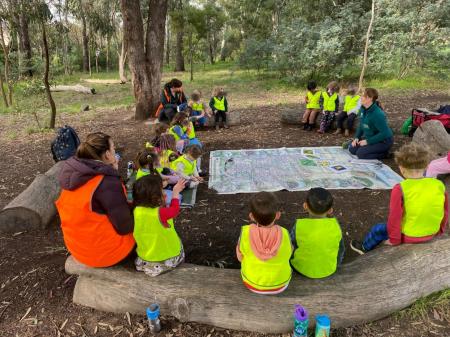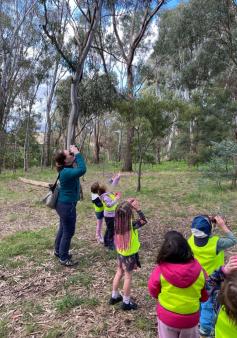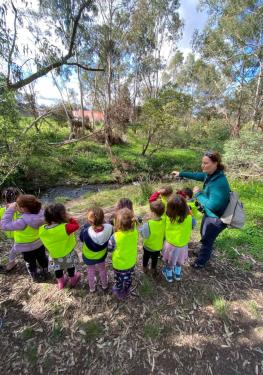When Lauren Branch walks along the Merri Creek in the hot, dry seasons of Gunyang (kangaroo apple season) and Biderang (hot and dry), there are usually around 20 pairs of little feet following close behind. As a teacher at Coburg’s Barry Beckett Children’s Centre (which enjoys a location just five minutes’ walk from the Merri) Lauren sees the creek as the perfect setting for place-based learning.
“Interacting with the creek gives opportunities for STEM (Science, Technology, English and Mathematics) as well as environment and wellbeing,” she says.
One of the concepts that Lauren enjoys exploring with her four- and five-year old kinder students is the changing of seasons according to what they are noticing in front of them, guided by the Wurundjeri seasonal calendar.
“At the beginning of the season, everything's quite green at the creek,” says Lauren. “You see more flowers out this time of year, but it will start to dry out very soon – even on the ground. The eucalyptus trees present in these really beautiful colours, all the way from yellows and reds, to pinks and greens, muted yellows and browns, even into purply colours.”
 Students from Barry Beckett Children's Centre, with MCMC's Julia Cirillo.
Students from Barry Beckett Children's Centre, with MCMC's Julia Cirillo.
Adapting to the heat
Visits to the creek must be planned carefully around the conditions this time of year.
“It's so hot and stormy, it's harder to get out than other times. We walk up along the Merri to the shady spots and also to Yaruk'ho Wilam (the stormwater wetlands near the confluence of Edgars and Merri Creeks).”
The season brings opportunities to observe the changes in the appearance of the plants and the behaviour of the creatures.
“There’s a subtlety that you miss until you slow right down and then you get to see all the different shapes of the grass flowers. We ask the children to think of words that describe all the different textures they see – like ‘fluffy’, ‘spikey’ or ‘rounded’. Sometimes grasses have big seeds and sometimes they have small seeds.”
“The children are really interested in birds – in Porneet we saw the eggs in the nest, then little chicks’ heads popping out. Now, in Biderap, we can see the birds out looking for food and bringing it back to the nest – and the young birds starting to fledge.”
“The children recognise that one season is over and we are looking out for new things now. Bugs come out for the flowers, and so the birds come out to feed on the bugs. We love to notice those connections and how one thing feeds into another.”

Learning about community
According to Lauren, spending time on the creek also allows the children to learn about belonging and place.
“You can learn about community through engaging with the creek – we’ve done litter cleanups with the support of MCMC.”
“We see little skinks and a blue-tongue lizard sometimes in Gunyang – usually we spot them because they’re basking on a rock in the sun. The insects are quite loud along the creek too – you can hear them calling to each other and there are lots of butterflies.”
The children observe the challenges that indigenous creatures have this time of year as well.
“Staying cool and having access to clean water in the heat can be a challenge,” says Lauren. “You can see the birds sitting there with their mouths wide open, panting, on a hot day.”
Our seasonal work plan in Gunyang

Meanwhile, along the creek, the MCMC ecological restoration team are also noticing changes.
“Grass seed is ripening, helped along by sunny, dry days,” says Jess Slade, Team Leader. “We might collect some in December and store it for direct seeding in the cooler months (Waring), so that when we remove weeds there is some competition.”
“During Gunyang, we look for the characteristic flutter of male Golden Sun Moths and the golden wings of the females sitting on the ground.”
Biderap can be a challenging season to work outdoors, so the team adapt their work practices accordingly. Days start earlier to make the most of the coolest hours, work is scheduled in cooler settings. Water is essential, both for keeping team members hydrated and in case activities like brush cutting could spark a grass fire. And on days of extreme heat (like this week), outdoor tasks can be swapped for housekeeping tasks.
The work plan also adapts to the season. Teams begin to focus on removing perennial weeds before they drop mature seeds. Perennial weed species like Chilean Needle Grass become more visible as they retain their colour. And in harsh years with lower rainfall, Jess and the crews help recent plantings by watering.
Jess also takes the movement of snakes into account when considering where to work.
“We know reptiles are active so we don't hand-weed in areas we can’t see through, particularly through patches of common tussock grass, which grows near water, providing excellent habitat for Tiger Snakes to rest and to hunt for frogs.”
If you’re out on a hot, Guling night (in temperatures over 14C and especially with light winds) you might be in for a special treat – listen up and see if you can hear the endangered Growling Grass Frogs begin to call.





 Merri Creek Management Committee. 2 Lee St, East Brunswick, Victoria, Australia 3057
Merri Creek Management Committee. 2 Lee St, East Brunswick, Victoria, Australia 3057